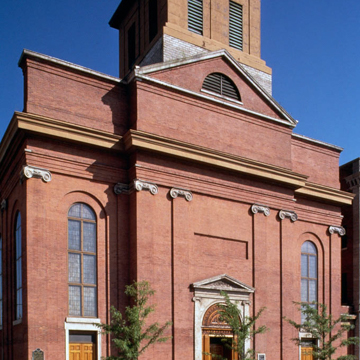SS. Peter and Paul Jesuit Church is a fine example of Catholic religious architecture. The neoclassical church that is closer to English Regency than any other style was designed by Letourneau (d. 1860) and Kindenkens supervised construction. The former was a native of Mount Clemens, who came to Detroit in the 1830s and was one of the first architect-builders to arrive here. Paired Ionic pilasters frame the modest, slightly projecting, pedimented, central bay of the large, Flemish bond, orange brick church. A low, triangular pediment surmounts the arched central entrance. The square squat tower, which was designed to include a steeple that resembles those created by James Gibbs but which was never built, dominates the street facade. The church follows the three-aisled basilica plan, has a barrel-vaulted ceiling, and seats 1,000. Marble wainscoting lines the interior. The apse has a Carrara marble altar of ornate Renaissance design by Gustave Adolph Mueller of Detroit decorated with sculpture by Joseph Gibbel of New York City. Having served its parishioners for more than 160 years, the church is the oldest extant in Detroit. Through the years, as the surrounding neighborhood changed from residential to commercial, the congregation, mainly Irish at the outset, decreased; but the church remains a symbol of Catholicism in Detroit.
You are here
SS. Peter and Paul Jesuit Church
1844–1848, Francis Letourneau and Peter Kindenkens; 1857, 1877, 1879, 1882, 1892, 1908 additions and alterations. 629 E. Jefferson Ave.
If SAH Archipedia has been useful to you, please consider supporting it.
SAH Archipedia tells the story of the United States through its buildings, landscapes, and cities. This freely available resource empowers the public with authoritative knowledge that deepens their understanding and appreciation of the built environment. But the Society of Architectural Historians, which created SAH Archipedia with University of Virginia Press, needs your support to maintain the high-caliber research, writing, photography, cartography, editing, design, and programming that make SAH Archipedia a trusted online resource available to all who value the history of place, heritage tourism, and learning.


